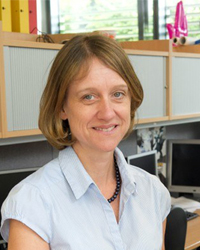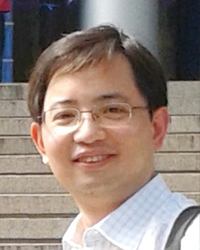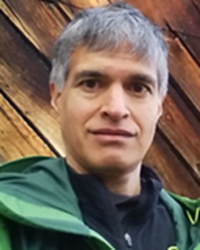Active Authentication in Mobile Devices
Julian Fierrez and Vishal Patel
Monday, August 20, 2018, 09:00-12:15, 306B, 3rd Floor
Tutorial Abstract
Recent developments in sensing and communication technologies have led to an explosion in the use of mobile devices such as smartphones and tablets. With the increase in use of mobile devices, one has to constantly worry about the security and privacy as the loss of a mobile device would compromise personal information of the user. To deal with this problem, active authentication (also known as continuous authentication) systems have been proposed in which users are continuously monitored after the initial access to the mobile device. This tutorial will provide an overview of different continuous authentication methods on mobile devices. We will discuss merits and drawbacks of available approaches and identify promising avenues of research in this rapidly evolving field. The tutorial should prove valuable to security and biometrics experts, exposing them to opportunities provided by continuous authentication approaches. It should also prove beneficial to experts in computer vision, signal and image processing, introducing them to a new paradigm of practical importance with very interesting research challenges.
Tutorial Outline
Ø Continuous authentication motivation and background (30 minutes)
Ø Speech-based approaches (15 minutes)
Ø Face-based approaches (30 minutes)
Ø Break (30 minutes)
Ø Typing patterns and touch gesture-based continuous authentication approaches (15 minutes)
Ø Other approaches including search patterns, gait-based, methods based on accelerometer and gyroscope, etc. (15 minutes)
Ø Fusion of multiple modalities (15 minutes)
Ø Acceptability, attacks on continuous authentication systems and hardware constraints (15 minutes)
Ø Publicly available datasets and results (15 minutes)
Ø Q&A (15 minutes)
Speaker Introduction

Julian Fierrez [M’02] received the MSc and the PhD degrees in telecommunications engineering from Universidad Politecnica de Madrid, Spain, in 2001 and 2006, respectively. Since 2002 he has been affiliated with the ATVS Biometric Recognition Group, first at Universidad Politecnica de Madrid, and since 2004 at Universidad Autonoma de Madrid, where he is currently an Associate Professor since 2010. From 2007 to 2009 he was a visiting researcher at Michigan State University in USA under a Marie Curie fellowship. His research interests include general signal and image processing, pattern recognition, and biometrics. Since 2016 he is and Associate Editor for IEEE Trans. On Information Forensics and Security and the IEEE Biometrics Council newsletter. Prof. Fierrez has been actively involved in multiple EU projects focused on biometrics (e.g. TABULA RASA and BEAT), has attracted notable impact for his research, and is the recipient of a number of distinctions, including: EURASIP Best PhD Award 2012, Medal in the Young Researcher Awards 2015 by the Spanish Royal Academy of Engineering, and the Miguel Catalan Award to the Best Researcher under 40 in the Community of Madrid in the general area of Science and Technology. In 2017 he has been also awarded the IAPR Young Biometrics Investigator Award, given to a single researcher worldwide every two years under the age of 40, whose research work has had a major impact in biometrics
 Vishal M. Patel [SM'16] is an A. Walter Tyson Assistant Professor in the Department of Electrical and Computer Engineering at Rutgers University. Prior to joining Rutgers University, he was a member of the research faculty at the University of Maryland Institute for Advanced Computer Studies (UMIACS). He completed his Ph.D. in Electrical Engineering from the University of Maryland, College Park, MD, in 2010. His current research interests include signal processing, computer vision, and pattern recognition with applications in biometrics and imaging. He has received a number of awards including the 2016 ONR Young Investigator Award, the 2016 Jimmy Lin Award for Invention, A. Walter Tyson Assistant Professorship Award, Best Paper Award at IEEE AVSS 2017, Best Paper Award at IEEE BTAS 2015, and Best Poster Awards at BTAS 2015 and 2016. He is an Associate Editor of the IEEE Signal Processing Magazine, IEEE Biometrics Compendium, and serves on the Information Forensics and Security Technical Committee of the IEEE Signal Processing Society. He is a member of Eta Kappa Nu, Pi Mu Epsilon, and Phi Beta Kappa
Vishal M. Patel [SM'16] is an A. Walter Tyson Assistant Professor in the Department of Electrical and Computer Engineering at Rutgers University. Prior to joining Rutgers University, he was a member of the research faculty at the University of Maryland Institute for Advanced Computer Studies (UMIACS). He completed his Ph.D. in Electrical Engineering from the University of Maryland, College Park, MD, in 2010. His current research interests include signal processing, computer vision, and pattern recognition with applications in biometrics and imaging. He has received a number of awards including the 2016 ONR Young Investigator Award, the 2016 Jimmy Lin Award for Invention, A. Walter Tyson Assistant Professorship Award, Best Paper Award at IEEE AVSS 2017, Best Paper Award at IEEE BTAS 2015, and Best Poster Awards at BTAS 2015 and 2016. He is an Associate Editor of the IEEE Signal Processing Magazine, IEEE Biometrics Compendium, and serves on the Information Forensics and Security Technical Committee of the IEEE Signal Processing Society. He is a member of Eta Kappa Nu, Pi Mu Epsilon, and Phi Beta Kappa
previous First Page





